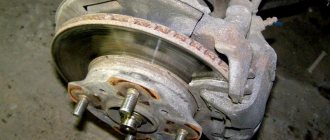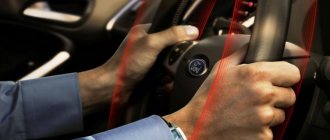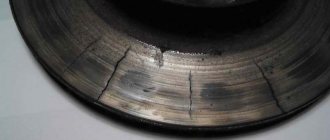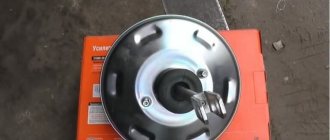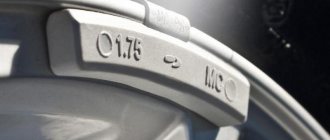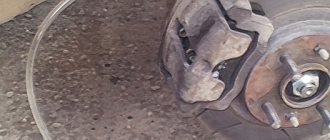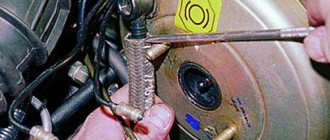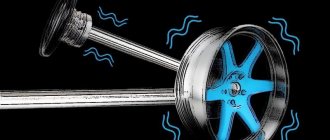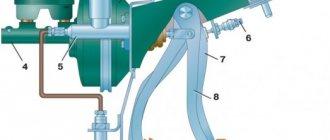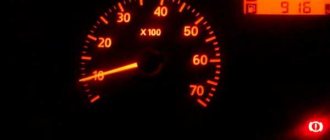When the brake system is working properly, the car stops smoothly, the driver feels the responsiveness of the pedal when it is pressed. The stopping trajectory is straight, without a roll to the left or right. When the brake pedal hits during smooth braking, this indicates a malfunction. The methodology for finding causes depends on the behavior of the machine. It must be said right away that with timely maintenance and compliance with the regulations, this problem should not exist. But there are also exceptions.
The main reasons for the brake pedal beating
Analyzing the reasons that can cause the brake pedal to beat, it is worth noting that they can be conditionally divided into direct, directly related to the braking system, and indirect, related to malfunctions of the suspension system, human factor and other similar manifestations.
So, among the main reasons it is worth highlighting the following:
- Warped brake discs are one of the most common problems. It usually occurs under the influence of a large number of heating/cooling cycles, causing deformation;
- Brake pad malfunctions are a problem that also occurs quite often and, as a rule, develops under the influence of long-term use;
- Rear brake drum - wear or distortion of this unit causes significant vibration in the brake pedal;
- Rear brake pads - here the root cause of the malfunction can be a number of destructive factors, including wear, crumbling and sticking of the drums;
- Brake cylinders, both front and rear, are a rather unpleasant situation in which acidification occurs and, as a result, the operating parameters of the elements deteriorate.
However, quite often, even correcting all of the above problems is not a guarantee of restoring system functionality. Here, as a rule, we are talking more about indirect factors that are not directly related to the system, but affect its operation.
Warped tires or wheels
The cause of various vibrations can be crooked wheels. This is easy to identify on a balancing stand. More often, the wheel becomes deformed when it falls into a large hole. You can determine a crooked disk yourself. It is enough to visually inspect the wheel. Stamped discs are more susceptible to deformation.
A badly worn tire is also a common reason for the brake pedal to squeal when braking. The VAZ-2110 has a reliable design, but sometimes the cause of vibrations needs to be looked for here, rather than changing discs and pads. The cord on the tire may be damaged, causing part of it to become convex.
It is impossible to solve the problem without replacing the wheels. Most often they have to be replaced, especially when the damage is serious. There is an option to ride with them after balancing. However, the vibrations will take a very long time to disappear until the tread becomes uniform on one side and the other.
Balance imbalance
Often, neither a tire nor a rim is ideal both in its shape and in terms of geometry characteristics. Since the weight in different parts is different, during the rotation of the wheel, the place where the mass is greater will pull the central part of the wheel along with it. This is how centrifugal force works. If the wheel rotates quickly and the car is traveling at high speed, then this force will turn into vibration. This is the reason why the brake pedal and steering wheel hit when braking.
If you drive on such wheels for a long time, the tire will wear unevenly, and this will lead to even greater vibrations. This also causes increased wear on car suspensions. The wheel bearing suffers the most from this.
The main symptom of imbalance is vibrations on the steering wheel. To diagnose this, the wheels are carefully inspected. If they are even, and the car did not drive through holes, then the problem lies precisely in the imbalance.
What to do if the brake pedal hits when braking
To get rid of the unpleasant sound, it is necessary to normalize all components and components that affect the operation of the brake system. It is better to replace all unusable mechanisms, but this will require material costs. Therefore, there are other ways to restore mechanical parts - eliminating defects on metalworking machines (grooving, grinding and other processing of metal parts). This method is carried out once, since spare parts become thinner and can become deformed during vehicle operation. Drivers with an active driving style should refrain from experimenting.
Diagnostics
Checking brake discs with a micrometer;
So, we have looked at the probable causes of the brake pedal beating. How can we determine which of them played a negative role in this particular machine? This requires a comprehensive and thorough diagnosis. And it is best if the research is carried out in a specialized car service center.
As part of diagnostic activities, the following work is performed:
- checking the geometry of discs and drums;
- checking the pads;
- testing of wheel bearings;
- inspection of suspension fasteners.
The geometry of discs and drums is checked on a special stand, which accurately records the curvature of the flat pressure pad of the disc and the ellipticity of the inner surface of the drum. To determine the degree of pad wear, use a caliper or micrometer. The condition of the wheel bearings is determined using special equipment that determines the amount of camber and toe-in of the rotating wheels from the normal position.
How to check if the brake pedal is beating?
To do this, you need to go to a dry, uniform surface. Of course, it is best if it is asphalt. To complete the picture, you need to disable ABS. If this is not possible, then try to drive in such a way that the system practically does not interfere with the braking process.
Then they accelerate to 80 km/h. They try to brake sharply without the wheels being locked. If the brake pedal hits when braking, then you should think about diagnostics and repair. If there are large vibrations on the steering wheel while reducing speed, it is necessary to reduce the pressure on the pedal and stop the car smoothly.
Improperly performed fluid change or brake bleeding
If you bleed the brakes, but the pedal still falls, this indicates a failure to comply with the procedure.
The sequence of actions differs for right- and left-hand drive cars, and each individual car model may have its own characteristics. In this case, you need to check the correctness of execution, or contact a specialized service center. Many experts prefer to use special pumping equipment for pumping. It allows you to create higher pressure in the system and make the hydraulics work as efficiently as possible. After bleeding the brakes in the usual way by pressing the pedal, the brakes often become sluggish and require repeating the procedure.
Why does the pedal hit when you press the brake?
The brake system of a car consists of a small number of components. Therefore, you can quickly determine why the car behaves this way. On the other hand, they all influence the behavior of the brake pedal to a certain extent.
Brake discs
The obvious reason is that the brake disc has a broken geometry. Curvature occurs due to a sharp temperature change. When driving in the mountains, the working surface quickly heats up. Deformation occurs due to sudden cooling, caused, for example, by falling into a puddle. To fix the problem, you need to replace or sharpen the set on the axle.
Not always, but vibration can appear after repair work. After grinding in the new parts, the problem will disappear.
Pads
Both the front and rear sets are subject to diagnostics. If the pads are worn beyond the maximum allowable value, the owner should replace them as soon as possible. The kit is installed in pairs, on each side of the axle. This is necessary to evenly distribute loads throughout the braking system.
Brake cylinders
A characteristic symptom of a damaged or deformed cylinder is the presence of traces of DOT 4 fluid on the inside of the wheel, sometimes on the asphalt. If the part is intact, it is necessary to lubricate it, thereby preventing jamming. The danger of fluid leakage is explained by the possibility of completely losing the brakes, which will lead to an accident.
Rear drum
On domestically produced cars, disc brakes with a caliper are often installed at the front. Since the rear axle consists of an axle, the designers decided to install a drum. After removing the protective cover, you need to check the condition of both the drum itself and the pads. If they are severely worn, they need to be completely replaced.
The grinding noise constantly intensifies and is quite sharp.
One of the most common situations in which you will need to use the help of specialists at a service station is an increase in grinding or a sharp, strong sound of metal rubbing against metal. Most likely, the block is completely worn out; you continue to brake with the sole of the block, which is made of hard metal. If this problem is not addressed promptly, the brake disc may fail and require replacement. In this case, repairs will be three times more expensive, so it is better to immediately identify all possible malfunctions and problems that caused the grinding noise when braking. In particular, to diagnose this problem, it is enough to carry out the following processes:
- determine from which side the grinding sound is heard, this will help you halve the amount of work required for diagnosis;
- remove the wheel that you suspect is making unpleasant sounds when braking;
- examine the exposed brake disc for grooves, chips and other problems with the working surface;
- look at the remaining layer of the brake pads, determine the degree of wear and the need for replacement;
- also examine the second wheel on this side, and best of all, examine the braking system on all wheels;
- Identify possible problems that could lead to squeaking and consult with specialists.
This will often help you determine the cause of the squealing noise when braking for free, but disassembling the brake system and performing repair work yourself is not always wise. You can use the services of specialists and guarantee the normal operation of the brake system. However, it is quite possible that all braking systems visually appear to be in good working order, but the grinding noise is still present. Then see if the car's behavior has changed during braking. If there are changes, you will have to pay more attention to this problem. If there are no changes, you can continue to operate the car until the grinding noise intensifies and gives specific clues.
How to avoid car brakes from squealing
If the brake pedal begins to vibrate when pressed, then this problem will not go away on its own. It is necessary to diagnose the machine as soon as possible and eliminate the malfunction. To avoid such troubles in the future, you need to follow these recommendations:
- Monitor the brake fluid level in the reservoir;
- Regularly check the brake system for leaks;
- Change the pads on time, without waiting for their maximum wear.
The braking system is nothing to joke about, and at the first symptoms of its malfunction, the problem should be eliminated.
Welcome, friends, to the DIY car repair website. Driving a car is always a certain risk, the level of which depends on the serviceability and correct functioning of the main systems. In this case, the most important component remains the brakes.
Brake pedal squeaks when braking
The efficiency of their work determines overall traffic safety. If the brake pedal hits when braking, this cannot be ignored. The consequence of such a breakdown may be partial or complete failure of the system.
Summarizing
The vibration of the brake pedal when braking is one of the symptoms of a malfunctioning brake system. The consequences can be very different from simple wear of parts to the creation of emergency situations due to brake failure.
For full operation of the brake system, full contact between the surface of the friction lining of the pad and the brake disc is necessary. If replacing worn parts helped only temporarily, maybe you should think about changing your driving style, because it is your driving style that affects the service life of the parts.
You should also not allow the temperature of heated elements (discs and calipers) to change; try to avoid puddles after braking, and also allow the brakes to cool before washing the car. To avoid breakdowns, you should visit service stations more often to check the performance and preventive maintenance of brake mechanisms, repair them in a timely manner, and also periodically inspect your brakes yourself.
You can test and find any faults in the brake system in your car on an empty section of the road, away from houses and pedestrians in order to avoid accidents.
First of all, you should carefully monitor the car’s braking process, listen to see if there are any extraneous noises or squeaks, whether the braking is uniform, or whether the direction of movement changes during sudden braking.
Probably one of the most serious troubles in a car is a malfunction of the brake system. And if the brake pedal hits when braking, you need to take immediate action. Indeed, in the event of an emergency, the car may not react to the press in time, and an accident will occur. The driver may become frightened by these beats and reduce the force of pressing the pedal. The only thing worse than this situation is a complete failure of the brake system. These vibrations on the pedals can also be accompanied by feedback to the steering wheel. Let's figure out where these vibrations come from, what can hit the pedal, and how to solve this problem.
What else causes beats and vibrations?
These reasons are rare, but still need to be considered. Sometimes there are minor problems with the steering rack or the ball joints of the car's chassis are too worn.
Also, vibrations and beating will occur due to worn shock absorbers. But in this case, the effect will be felt at the moment of turning. Also, beating in the brake system and steering wheel can be caused by strong impacts of the car.
Ball joints
Experienced car enthusiasts recommend carefully checking the entire chassis.
For inspection, the car is jacked up, and the ball joint is installed so that the wheel hangs in the air. Then, with the palm of one hand, take the wheel by the upper part, and with the other hand, by the lower part. You need to wobble the wheel with your hands. If the wobble is present and felt, then the ball joint must be replaced. This should eliminate vibrations and knocking.
Drum
During braking, not only the front but also the rear brakes are used. On many modern cars they are still drum-type. This mechanism can also cause the brake pedal to squeal when braking. The VAZ-2114 is equipped with such brakes at the rear, and there really is a problem with them.
If the drum is deformed or damaged, the brake pedal will also vibrate. Sometimes the body shakes too. Often, along with the drum, the rear pads also fail. The vibration problem is solved by replacing these consumables. Replacement is carried out on all two wheels of the rear axle.
Corrosion
Cars are still made of metal, which is known to be susceptible to corrosion. Even if the car is parked in a warm garage, and it sits for a fairly long period of time, rust may form at the point of contact between the discs and the pads.
If the car is parked long enough, it is not surprising that the brake pedal hits when braking. VAZ and many imported cars are susceptible to this problem. This happens quite often. This effect may disappear over time. The disc needs time until the pad erases this layer of rust from the surface. There is no need to change or repair anything.
The brake hits when the braking system is working properly
If the braking system has been checked, but defective elements cannot be detected, the problem may be hidden in less obvious reasons. In such situations it is recommended:
- Make sure the wheels are properly balanced. An experienced driver can easily determine that the wheels of a car are unbalanced. A clear symptom of this is the rolling of the entire body when the car is moving, and not just the beating of the brake.
- Check the front suspension arms for bending and secure fastenings.
- Check the condition of the wheel bearing. If it becomes excessively worn, it will need to be replaced.
- Make sure that the fastening of body elements, suspension, and braking system is secure. Often the cause of brake chatter is poor bolt tightening throughout the vehicle. This problem is especially relevant when driving on bad roads. Check the tightness of all accessible bolts on the vehicle.
Is it possible to ignore the problem?
The braking system is one of the most important, since driving safety and the efficiency of stopping a vehicle directly depend on it. Any disruption to operation is extremely undesirable and it is not recommended to travel with them.
Some drivers ignore vibration, which later leads to more serious problems or even accidents as braking performance is reduced. And if this is not important under normal conditions, it is greatly manifested in an emergency situation.
If it is noticed that the operation of the system is disrupted, first of all make sure that everything is in order with the parts, there is no visible damage or leakage of brake fluid. After which you can continue driving, but it is advisable not to postpone your visit to the auto repair shop. If braking efficiency has decreased, it is better not to take risks, but to immediately begin repairs or contact a service center.
By the way!
When driving an automatic transmission, if vibration appears when the brake is pressed in the “D” gearbox position, first check the automatic transmission support cushions. If everything is in order with them, then the vibration sensor is diagnosed.
Why does the pedal hit when braking: typical faults
Automotive technology contains a large number of different components, mechanical parts and mechanisms that affect the entire operation of the car and its individual sections, including the braking system.
Brake disk
This is a metal part of the hydraulic brake system that rotates simultaneously with the wheel and is pressed by the pads when the driver presses the brake pedal. One of the main causes of runout may be broken or warped brake discs. This is due to the temperature difference acting on the parts of the cooling system: due to sudden braking, the disk becomes hot, and when it gets into a puddle, it instantly cools down. As a result, the disc becomes deformed and hits the brake pedal when braking. Using the handbrake, the location of the breakdown is checked. If there is no vibration when you fix the handbrake handle, then the reason is in the front axle of the wheels. This problem is solved by replacing the discs on both wheels at once. If after this the pedal continues to knock, then this is most likely a temporary situation - the new parts should get used to it.
Corrosion
This is a chemical, physical-chemical or electrochemical process of destruction of metal and its alloys. In other words, the formation of rust when moisture enters. The reason for its appearance may be a temperature difference or a long stay in the air. In this case, the brake pedal will knock until the rust wears off at the point where the discs contact the pads. This is a common problem that does not require repair or replacement of parts.
Pads
This is one of the elements of the brake system. The pad comes into contact with the surface of the wheel or brake disc by pressing, after which the car slows down and slowly stops. With frequent and sharp pressure on the pedal during braking, the part is subjected to mechanical stress. Therefore, over time it wears off and crumbles. To determine the degree of wear of the elements, the rear and front pressure pads are simultaneously diagnosed and replaced.
Drum
The main mechanism of a drum braking system is a drum made from certain types of cast iron. The difference between a drum and a disk is that:
- in the drum assembly, the shoes expand and press on the inner walls of this element;
- The disc system compresses the brake pads.
This technology is already quite complex and outdated. But when moisture gets in, the drum braking system responds faster than the disc braking system. The latter requires experience, otherwise the driver risks losing control of the car. If the brake drum is damaged or deformed, the brake pedal and other parts of the car begin to knock. In this situation, you will need to replace not only the drum, but also the rear pads.
Brake cylinder
This is a mechanical unit that converts fluid pressure into mechanical force that acts on the brake pads. Unlike the main brake cylinder, it acts directly on the drum type pads. If the cylinder is covered with rust, it must be removed using a corrosion protection agent (WD-40).
Human factor
This point also cannot be excluded. Sometimes this happens, and the situations are very different. If, when replacing a wheel, you (or the mechanics) were in a hurry to finish the job, you might not have fully tightened the mounting bolts. Such inattention can lead not only to vibrations and beating on the pedals. This is how you can lose a wheel. As you can see, there are many reasons. They are all different. They all produce the same effect. You should carefully monitor the condition of the car and, if necessary, replace worn parts and components in a timely manner. It is also worth listening to the recommendations of car manufacturers.
So, we found out why the brake pedal hits when braking.
No need to delay eliminating vibrations
Using a car with such symptoms is fraught with dire consequences. Due to vibrations, hub bearings, guides in calipers, and brake cylinders quickly wear out. Over time, you will have to change the steering rack and tips. And this is not the entire list.
Brake discs and drums can be machined. This will help return them to the desired shape. But we must remember that this is a last resort measure. If the disk thickness is minimal (less than 20 millimeters), only replacement will help. Otherwise, they will overheat even more. Don't skimp on spare parts. If a brake pad overheats, it is not a fact that it will not lose its properties. But often for this reason the brake pedal hits when braking. “Priora” is equipped with an anti-lock braking system “ABS”, and many owners say that it is the fault of the electronics that the pedal hits. But it’s better to check once again and identify defective parts.
